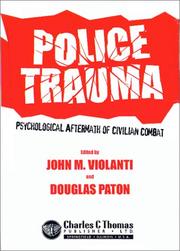| Listing 1 - 10 of 14 | << page >> |
Sort by
|
Digital
ISBN: 9780124096011 0124096018 Year: 2015 Publisher: Amsterdam Elsevier
Abstract | Keywords | Export | Availability | Bookmark
 Loading...
Loading...Choose an application
- Reference Manager
- EndNote
- RefWorks (Direct export to RefWorks)
More than 90% of wildfires are caused by human activity, but other causes include lighting, drought, wind and changing weather conditions, underground coal fires, and even volcanic activity. Wildfire Hazards, Risks, and Disasters, one of nine volumes in the Elsevier Hazards and Disasters series, provides a close and detailed examination of wildfires and measures for more thorough and accurate monitoring, prediction, preparedness, and prevention.
Book
ISBN: 039809098X 9780398090982 0398090971 9780398090975 9780398090975 Year: 2015 Publisher: Springfield, Illinois, U.S.A.
Abstract | Keywords | Export | Availability | Bookmark
 Loading...
Loading...Choose an application
- Reference Manager
- EndNote
- RefWorks (Direct export to RefWorks)
"Presents innovative multi-disciplinary perspectives on how people and societies respond to, and recover from sudden, unexpected crisis events like natural disasters which impact tragically on the established patterns and structures of their lives. Through detailed empirical analysis which employs both qualitative and quantitative research methodologies, the twenty-two chapters in this volume explore these critical issues. Chapters have a wide global range across both democratic and transforming governance systems which spotlight the many different ways in which different political jurisdictions respond to the demographic, planning and policy implications of the natural disasters affecting their citizens. The authors collectively provide insights into varying socio-cultural and political disaster frameworks from China, Japan, the USA, New Zealand, Myanmar, Indonesia, Taiwan, Iran, The Philippines and Pakistan. Taking the conceptual and analytical lens of social capital, family formation and migration patterns, the authors employ comparative demographic, anthropological and sociological approaches to present the human security contexts of natural disasters when they unexpectedly wreak havoc on human societies, and the coping and response behaviors they adopt, develop and use as survivors as they set about re-building their lives over periods that can extend over several years"--
Disaster relief --- Natural disasters --- Emergency management --- Consequence management (Emergency management) --- Disaster planning --- Disaster preparedness --- Disaster prevention --- Disasters --- Emergencies --- Emergency planning --- Emergency preparedness --- Management --- Public safety --- First responders --- Natural calamities --- Disaster assistance --- Emergency assistance in disasters --- Emergency relief --- Human services --- Planning --- Preparedness --- Prevention --- E-books
Book
ISBN: 9780398088972 0398088977 Year: 2013 Publisher: Springfield, Illinois : Charles C Thomas, Publisher,
Abstract | Keywords | Export | Availability | Bookmark
 Loading...
Loading...Choose an application
- Reference Manager
- EndNote
- RefWorks (Direct export to RefWorks)
Despite the evident advantages that being prepared for natural life-threatening events confers on people and communities, research has consistently found that individual, community, and business preparedness levels are low. This book examines why this is so and identifies what can be done to expedite the development of sustained preparedness, at household, community, and societal levels. The text emphasizes the need for this aspect of social risk management to be based on engagement principles: how people engage with their natural environment, how they engage with each other, and how people an
Emergency management --- Preparedness --- Reliability --- Readiness --- Management --- Public safety --- First responders --- Consequence management (Emergency management) --- Disaster planning --- Disaster preparedness --- Disaster prevention --- Disaster relief --- Disasters --- Emergencies --- Emergency planning --- Emergency preparedness --- Planning --- Prevention --- Emergency management. --- Preparedness.

ISBN: 0063184451 Year: 1991 Publisher: London Harper Collins
Abstract | Keywords | Export | Availability | Bookmark
 Loading...
Loading...Choose an application
- Reference Manager
- EndNote
- RefWorks (Direct export to RefWorks)
Book
ISBN: 0398082936 Year: 1996 Publisher: Springfield : Charles C Thomas,
Abstract | Keywords | Export | Availability | Bookmark
 Loading...
Loading...Choose an application
- Reference Manager
- EndNote
- RefWorks (Direct export to RefWorks)
This book provides a comprehensive review of the recognition, consequences and treatment of traumatic stress in critical occupations. The term ""critical occupation"" describes both the critical role that members of the emergency and helping professions play in protecting communities and their members and the fact that, in the course of acting in this capacity, these professionals can encounter situations which may exert a critical impact on their psychological well-being. The text describes this phenomenon, not just from the point of view of the individual, but rather in terms of the interact
Book
ISBN: 0398088446 Year: 2012 Publisher: Springfield, Illinois : Charles C Thomas,
Abstract | Keywords | Export | Availability | Bookmark
 Loading...
Loading...Choose an application
- Reference Manager
- EndNote
- RefWorks (Direct export to RefWorks)
Wildfires represent a growing threat to environments, to people, communities, and to societies worldwide, particularly in the United States, Southern Europe, and Australia. Recognition of this growing risk has highlighted a need to develop people's capacity to adapt to annually occurring events that could increase in frequency and severity over the coming years and decades. The goal of ensuring sustained levels of protective measures in communities susceptible to wildfire hazard consequences has proved to be elusive. This book examines why this is so and identifies ways in which sustained leve
Fire management --- Fire management --- Wildfires --- Wildfires --- Wildfire risk --- Wildfire risk --- Prevention and control. --- Prevention and control.
Book
ISBN: 0398091706 9780398091705 9780398091699 0398091692 Year: 2017 Publisher: Springfield, Illinois
Abstract | Keywords | Export | Availability | Bookmark
 Loading...
Loading...Choose an application
- Reference Manager
- EndNote
- RefWorks (Direct export to RefWorks)
There is much that communities can do to mitigate their risk and manage disaster consequences. The construct that epitomizes how this is done is resilience. The contents of this volume provide valuable insights into how societal resilience can be developed and sustained.
Disasters --- Natural disasters --- Hazardous geographic environments. --- Risk management. --- Emergency management. --- Preparedness. --- Community organization. --- Resilience (Personality trait) --- Human resilience --- Resiliency (Personality trait) --- Personality --- CBOs (Community organization) --- Community-based organizations --- Community councils --- Community life --- Readiness --- Reliability --- Consequence management (Emergency management) --- Disaster planning --- Disaster preparedness --- Disaster prevention --- Disaster relief --- Emergencies --- Emergency planning --- Emergency preparedness --- Management --- Public safety --- First responders --- Insurance --- Environments, Hazardous geographic --- Human ecology --- Natural calamities --- Calamities --- Catastrophes --- Curiosities and wonders --- Accidents --- Hazardous geographic environments --- Social aspects. --- Planning --- Preparedness --- Prevention --- Emergency management

ISBN: 0398069549 0398069557 Year: 1999 Publisher: Springfield, Ill. Thomas
Abstract | Keywords | Export | Availability | Bookmark
 Loading...
Loading...Choose an application
- Reference Manager
- EndNote
- RefWorks (Direct export to RefWorks)
Book
ISBN: 039808694X Year: 2011 Publisher: Springfield, Illinois : Charles C. Thomas,
Abstract | Keywords | Export | Availability | Bookmark
 Loading...
Loading...Choose an application
- Reference Manager
- EndNote
- RefWorks (Direct export to RefWorks)
The impact of events such as the 9/11 terrorist attacks and Hurricane Katrina were felt across the spectrum of organizations. Such events provide vivid illustrations of the exceptional circumstances that emergency and protective service agencies and businesses alike can encounter. The goal of this book is to broaden the perspectives on the populations that need to be included when thinking about high risk groups and from whom insights into resilience and how it is enacted can be sought. The first chapter discusses high risk environments, sustained resilience and stress risk management. Chapter
Job stress. --- Hazardous occupations --- Emergency management --- Resilience (Personality trait) --- Stress management. --- Psychological aspects.
Book
ISBN: 0398090343 Year: 2006 Publisher: Springfield : Charles C Thomas,
Abstract | Keywords | Export | Availability | Bookmark
 Loading...
Loading...Choose an application
- Reference Manager
- EndNote
- RefWorks (Direct export to RefWorks)
Persons engaged in occupations that require emergency responses must frequently deal with exposure to incidents that are traumatic. Some of these persons develop posttraumatic stress reactions or full-blown posttraumatic stress disorder, while others do not. A key issue in the development of traumatic stress is vulnerability. This book draws from research and life experiences on trauma vulnerability to better understand how mental health professionals and those concerned with the psychological well-being of others may disentangle the perplexing questions of who gets PTSD, why they do, and how
| Listing 1 - 10 of 14 | << page >> |
Sort by
|

 Search
Search Feedback
Feedback About UniCat
About UniCat  Help
Help News
News